Chapter: Mechanical : Engineering Economics & Cost Analysis : Depreciation
Worked out Problems: Depreciation
WORKEDOUT PROBLEMS
Single-Payment Compound Amount
A person deposits a sum of Rs.
20,000 at the interest rate of 18% compounded annually for 10 years. Find the
maturity value after 10 years.
Solution
P = Rs. 20,000
i = 18%
compounded annually n = 10 years
F = P(1 + i)n = P(F/P,
i, n)
= 20,000 (F/P, 18%, 10)
= 20,000 5.234 = Rs.
1,04,680
The maturity value of Rs. 20,000
invested now at 18% compounded yearly is equal to Rs. 1,04,680 after 10 years.
Single-Payment Present Worth Amount
A person wishes to have a future sum
of Rs. 1,00,000 for his son’s education after 10 years from now. What is the single-payment
that he should deposit now so that he gets the desired amount after 10 years?
The bank gives 15% interest rate compounded annually.
Solution
F = Rs. 1,00,000
i = 15%,
compounded annually n = 10 years
P = F/(1 + i)n = F(P/F, i, n)
= 1,00,000 (P/F,
15%, 10
= 1,00,000
0.2472
= Rs. 24,720
The person
has to invest Rs.
24,720 now so
that he will
get a sum of
Rs. 1,00,000 after 10 years at 15% interest rate compounded annually
Equal-Payment Series Sinking Fund
A company has to replace a present
facility after 15 years at an outlay of Rs. 5,00,000. It plans to deposit an
equal amount at the end of every year for the next 15 years at an interest rate
of 18% compounded annually. Find the equivalent amount that must be deposited
at the end of every year for the next 15 years.
Solution
F = Rs.
5,00,000 n = 15 years
i = 18% A =
?
The corresponding
cash flow diagram is shown in Fig.
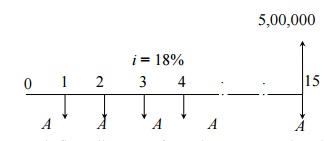
Fig. Cash flow diagram of equal-payment series sinking fund.

= 5,00,000(A/F, 18%,
15) = 5,00,000 0.0164 = Rs. 8,200
The annual equal amount which must be deposited for 15 years is
Rs. 8,200.
Equal-Payment Series Present
Worth Amount
A company wants to set up a reserve which will help the company
to have an annual equivalent amount of Rs. 10,00,000 for the next 20 years
towards its employees welfare measures. The reserve is assumed to grow at the
rate of 15% annually. Find the single-payment that must be made now as the
reserve amount.
Solution
A = Rs. 10,00,000 i = 15%
n = 20 years P = ?
The corresponding cash flow diagram is illustrated in Fig.
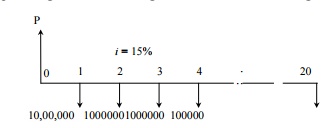
Fig. Cash flow diagram of equal-payment series present worth amount.
The formula to compute P is
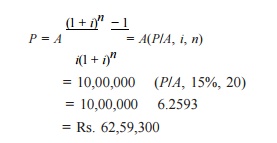
The amount of reserve which must be set-up now is equal to Rs.
62,59,300.
Equal-Payment Series Capital
Recovery Amount
A bank gives a loan to a company to purchase an equipment worth
Rs. 10,00,000 at an interest rate of 18% compounded annually. This amount
should be repaid in 15 yearly equal installments. Find the installment amount
that the company has to pay to the bank.
Solution
P = Rs. 10,00,000 i = 18%
n = 15 years A = ?
The corresponding cash flow diagram is shown in Fig..
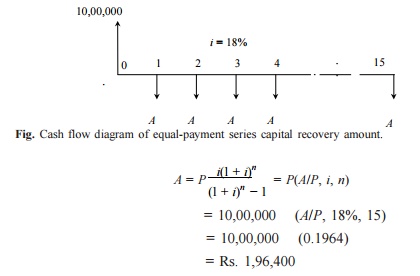
The annual equivalent installment to be paid by the company to
the bank is Rs. 1,96,400.
Uniform Gradient Series Annual
Equivalent Amount
A person is planning for his retired
life. He has 10 more years of service. He would like to deposit 20% of his
salary, which is Rs. 4,000, at the end of the first year, and thereafter he
wishes to deposit the amount with an annual increase of Rs. 500 for the next 9
years with an interest rate of 15%. Find the total amount at the end of the
10th year of the above series.
Solution
Here,
A1 = Rs. 4,000
G = Rs. 500
i = 15%
n = 10 years
A = ? & F = ?
The cash flow diagram is shown in Fig.
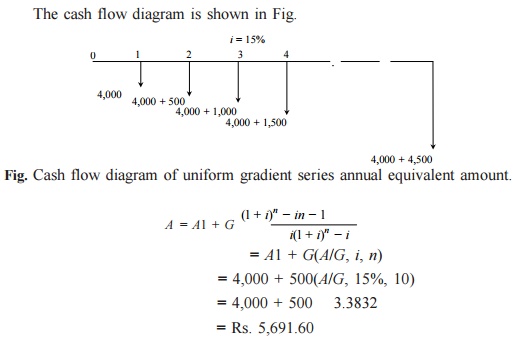
Fig. Cash flow diagram of uniform
gradient series annual equivalent amount.
This is equivalent to paying an
equivalent amount of Rs. 5,691.60 at the end of every year for the next 10
years. The future worth sum of this revised series at the end of the 10th year
is obtained as follows:
F= A(F/A, i, n)
= A(F/A, 15%, 10)
= 5,691.60(20.304)
= Rs. 1,15,562.25
At the end of the 10th year, the compound amount of all his
payments will be Rs. 1,15,562.25
Effective Interest Rate
A person invests a sum of Rs. 5,000
in a bank at a nominal interest rate of 12% for 10 years. The compounding is
quarterly. Find the maturity amount of the deposit after 10 years.
Solution
P = Rs. 5,000
n = 10 years
i = 12%
(Nominal interest rate) F = ?
METHOD 1
No. of interest periods per year = 4
No. of interest periods in 10 years = 10 4 = 40
Revised No. of periods (No. of quarters), N = 40 Interest rate per
quarter, r = 12%/4
= 3%, compounded quarterly.
F = P(1 + r)N = 5,000(1 + 0.03)40
= Rs. 16,310.19
METHOD 2
No. of interest periods per year, C = 4
Effective interest rate, R = (1 + i/C )C – 1
= (1 + 12%/4)4 – 1
= 12.55%, compounded annually.
F = P(1 + R)n = 5,000(1 + 0.1255)10
= Rs. 16,308.91
Related Topics